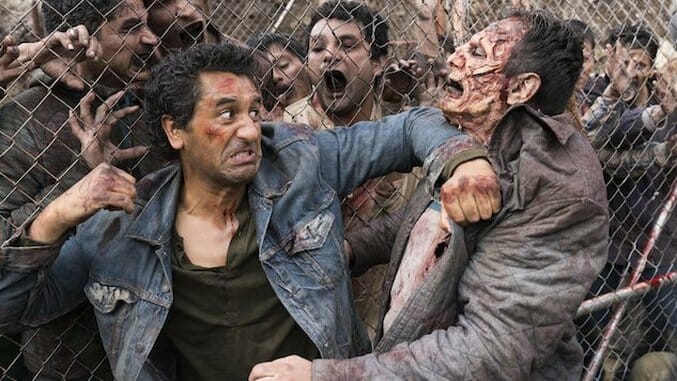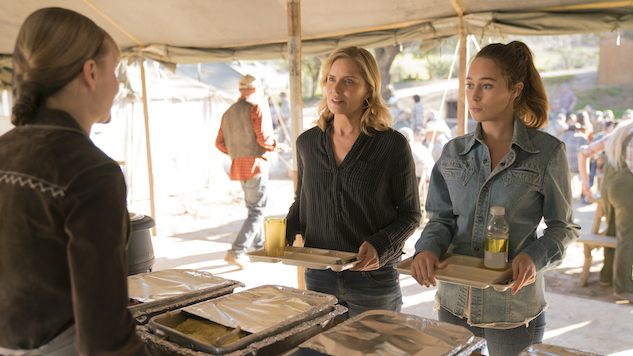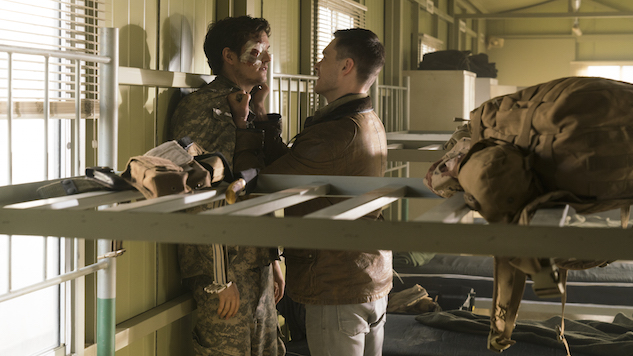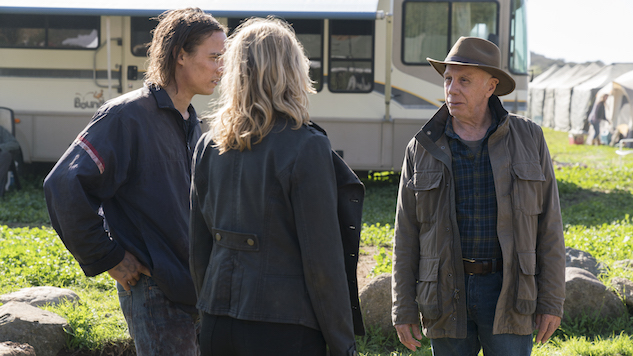Can Fear the Walking Dead Find Its Own Voice?
Images courtesy of AMC Networks TV Features Fear the Walking Dead
“You want the gory stuff? Let’s start with the gory stuff.”
It’s mid-morning on Mexico’s Pacific coast, four miles south of the Rosarito Beach Hotel, and veteran prop master Colin Thurston is showing off a pair of mannequin horses, each missing much of its torso. They, or at least the versions we’ll see on screen, have been set upon by “walkers,” the rotting, staggering figures at the center of AMC’s apocalyptic juggernaut, The Walking Dead, and now its prequel, Fear the Walking Dead. Thurston, discussing the slick, stomach-turning innards (horse, human, house pet) that appear on the series with metronomic regularity, even refers, at one point, to tripe, though it’s unclear to me whether or not he’s joking. (I’ll never eat it again.) Of course, gore and the implements that create it are as integral to Fear as to its predecessor: In his department’s hangar at Baja Studios, purpose-built in the 1990s for James Cameron’s Titanic, Thurston keeps hatchets, spears and guns of every conceivable shape and size, not to mention skulls, severed heads and jugs of stage blood; the animated Brit jokes that there must be a file on him at the Department of Homeland Security by now.
“‘Oh my God, he’s gonna kill!—No, it’s that bloody prop master from Titanic again.’”
Still, in the specifics of Fear’s gore—the Season Three premiere, “Eye of the Beholder,” contains some of the series’ most rococo tortures and punishments to date—Thurston confronts his most significant challenge.
“I’m on the back of seven seasons of The Walking Dead, so when something comes up in the script, I’ve got to try and think of something that they haven’t thought of,” he says. “In a way, it’s really nice for them to have that history, because it’s nice to know what I can’t do, but it’s really putting the pressure on me—because of the lot of the times, it’ll just be a line in the script.”
This is the challenge for Fear itself: To set a path distinct from The Walking Dead as it moves further and further from the initial response to the crisis—terrain well trod by the original, which finds itself in the midst of a creative and ratings decline. In part, Fear’s distinguishing feature is its landscape, whether the action occurs at sea, as in Season Two, or in remote corners of the American southwest, where much of Season Three is set. But as Fear fights lackluster reviews, and perhaps an element of Dead fatigue—after a record-setting debut in 2015, viewership has returned to Earth—its boldest gambit may be to engage with a subject The Walking Dead has for the most part scrupulously avoided: the zeitgeist.
Though she’s careful not to overemphasize the new season’s connection to the political climate, executive producer Gale Anne Hurd admits that the action, which straddles the U.S.-Mexico border and features military, paramilitary and civilian groups vying for scant resources, is “playing out on the broader national canvas” as well.
“Our writers pick up [on] flashpoints and can incorporate [them] into the storytelling, and it makes it seem like they’re clairvoyant,” Hurd says, sitting in a spare production office at Baja Studios. “There’s a lot of discussion to be had about preconceived notions, how expectations can lead to consequences.”
Though AMC’s faith in the franchise is, for now, unwavering—the network has already renewed Fear for a fourth season, and The Walking Dead for an eighth—both series have shed viewers with worrisome speed, suggesting that audiences are frustrated with their not-infrequent lapses of narrative judgment: Fear, for instance, saw its average number of total viewers fall from 11.2 million in Season One to 5.3 million in Season Two, a 53% decline; in the 18-49 demographic sought by advertisers, the drop was even more precipitous, from 7.3 million to 3 million, or 59%. (Both comparisons are drawn from Live+3 data, which includes three days of time-shifting after an episode first airs.) In the fragmented era of “peak TV,” with its proliferation of original scripted series and places to watch them, ratings for both Fear and The Walking Dead remain strong compared to the competition, but the former’s shift toward the topical is nonetheless promising, if the series is to stanch the bleeding.
The sets built at Baja Studios—an unlit barracks marked by blood and grime, a trailer filled with the dream catchers and totem poles of Native American lore—begin to suggest Season Three’s risk, and its potential reward, which is to reinvigorate Fear by reflecting the ideological, racial and geographical divisions that mark our own moment. As Hurd notes, Fear is poised to consider the surprising alliances, and internecine conflicts, that erupt in the aftermath of cataclysm.
“No one,” she adds, “gets out unscathed.”
“Did somebody pay this guy?”
It’s approaching four o’clock in the hills above Ensenada, and the voice in my headset evinces palpable, if still jocular, frustration. With rain set to move in by morning, turning the rutted roads to the location into impassable slurries of mud, the Fear team is racing the elements—and thereby the clock—to film an intricate sequence from the midseason finale. (In the longest single shot, the camera must pass through more than a dozen performers, each with his or her own complex blocking, before reaching the main cast in an olive-green tent.) So far, it’s not going well: One background player misses his cue on more than one occasion, and affirmations of “We’ll get it! We’ll get it!” segue into the more vexed “We gotta lock it up.”
“The Ranch,” as it’s known on set, is situated on the eastern slope of the high ridge that separates the bucolic inland of Baja California from the bustle of the coastal highway. Tucked into a compact valley, replete with garden, tents and rows of RVs, its centerpiece is the sprawling, wood-frame house perched above the basin’s floor—home, in Season Three, to the leader of “a new nation” of preppers that springs into action when the long-awaited apocalypse arrives. Though it appears as if discovered, in toto, amid the cow-dotted hills, The Ranch is, in fact, brand new. Production designer Bernardo Trujillo describes it as “our biggest set, our biggest achievement, our biggest build of the season.”
“The challenge was to find a 360-degree space that looked like it could be in the border between California and Arizona, or in New Mexico—the [southwestern] U.S.,” Trujillo says, standing in a rectangular room back at Baja Studios, its two longest walls papered with gorgeous, detailed, near-photorealistic renderings of the season’s main sets. Though the terrain itself was ideal, Trujillo explains, the architecture of the landowner’s home ill-suited the series’ purposes, so the Fear crew designed a cabin that could “swallow” the existing structure whole—and then erected it over the course of four cold, wet weeks last winter. The result is remarkable: More than a mere “carcass,” to use Trujillo’s term, the cabin features an interior with stone floor and columns, decorated to resemble a comfortable study, and a porch overlooking the property below.
In the process of creating the cabin and—in one of the studio’s warehouse-sized buildings—the sets for The Ranch’s underground storage facilities, Trujillo’s team conducted research on real-life preppers. He compares the basement units, augmented in post-production with green-screen CGI, to the immense structure in which the Ark is placed for safekeeping at the end of Raiders of the Lost Ark, “full with secrets.”
“These people take things very diligently and seriously, how to prep for the apocalypse, although they’re probably expecting a different type of apocalypse,” he says. “That was sort of the inspiration: You enter a place that seems small, and as the camera sort of opens and reveals it, [you realize] this is serious. These people are prepared for, really, the end of the world.”
As co-creator and showrunner Dave Erickson explains, sitting in the shade cast by one of the RVs parked at The Ranch, there’s an inherent dramatic tension in the meeting of disparate communities under crash circumstances. (Erickson is slated to depart from his role at the end of Season Three, as part of a new, multi-year development deal he signed with AMC Networks in March.)
“There’s a line, I’m paraphrasing, ‘Civilization’s not hard.’ If you have resources and you’re willing to kill to protect them, those are your building blocks, and you can get into rule of law down the road,” Erickson says. “The difference is, we have a group, in this militia group—these are guys that used to patrol the border, these are guys that I, personally, politically abhor, but these are people that felt they were protecting our country… They were preppers. They assumed democracy was going to fall. And so they had everything in place. The irony for me is that, a group that one—depending on your political leanings—may not find seemly, they actually are ready for this in a way most people are not.”
Though Erickson notes that there are no explicit connections to the new administration’s policies in Season Three (“We’re not going to have a Trumpian character,” he promises), he considers the series’ echoes of real-world concerns, from the immigration debate to right-wing separatism, an aspect of the overarching narrative.
“There are two things at work here,” he says. “One is this concept of our border, and protecting our border, and protecting our families—which, taken to the extreme, as some have, and taken to the extreme as these folks do, is incredibly dangerous and becomes incredibly, incredibly ugly… The irony of the show right now is that there are no borders. There’s a false construct at the start, because when you look at how our borders were defined and how certain land was stolen, certainly was appropriated, there’s a rich and tragic history of that throughout the country, [especially] in the southwest.”
The result, in the new season’s first three episodes, is a sense of the subject matter’s fraught—if not yet fully realized—possibilities: Intimations of ethnic violence, competing agendas, and reversals of fortune that cut both along and against the historical grain. But even those with a modicum of power in this new world are coming to recognize that the fight for survival is only beginning. “This is triage,” one character laments in “Eye of the Beholder.” “It’s all triage.”
With the wind rising, the sun fading and the temperature dropping, though, there’s no time for philosophizing, not if the scene from the midseason finale is to finish shooting on schedule. The atmosphere has grown serious since rehearsals earlier, when I hear lead actress Kim Dickens asking her young co-stars if they know Ricky Schroeder (she was his first on-screen kiss), and listen in through the headset as members of the cast discuss their distaste for La La Land; as the takes mount, the set assumes an urgent air, cast and crew hustling in and out of the frame with each reset.
“Very close!”
“We’re gonna get there.”
“Great things don’t happen immediately, guys.”
From my half-obscured vantage, unable to see either the monitors or the action inside the tent, the eighth go-round seems smoothest, as crisp as a fresh apple, though by the time Erickson is available to meet, the count is up to 11. (It will get done, in the end; it always does.)
“He likes a lot of takes,” I hear someone say, sighing, as I leave the area where they’re filming, presumably about the director—I decide that now isn’t the moment to ask. “And it’s taking forever.”

“High school kids: Just like zombies.”
It’s after midnight in a cramped corner of The Ranch’s main structure, and Dickens is laughing at the training her character, guidance counselor and mother of two Madison Clark, draws on to navigate the ragged edges of Fear’s broken order. The schedule change means that Dickens and the rest of the cast have had to squeeze in the next episode’s table read over dinner, after which she’s filmed an interior scene containing one of her longest monologues in the series to date. It’s a marvel she’s still standing, much less submitting to an interview—though the veteran performer, known for her roles as brothel madam Joanie Stubbs in Deadwood and chef Janette Desautel in David Simon’s Treme, among others, is used to the mercurial nature of making television. Still, she hesitates slightly when I ask about Fear’s clashes, of both the human and geographical sort, as if skeptical of the question. (It may simply be badly phrased on my part; Dickens is in high spirits, but I’m absolutely wiped.)
“I haven’t really thought of it that way,” she says. “Madison’s present is definitely colliding with her past right now, so we’ll get to sort of understand what she’s held inside. The metaphors of the border and two countries meeting and different ethnicities and desert meeting ocean and all that, I think it is our dark and light sides wrestling with each other. I think that’s our metaphor.” Dickens compares Madison to the frontiersman of David Milch’s epochal Western: “The end she desires is benevolent, but I think the means to the ends are, maybe, morally compromised. You know, you gotta do what you gotta do. It’s like Swearingen in Deadwood. It’s like, whatever’s best for the town. You sometimes gotta get rid of a bad egg if you have to. It’s that line of thinking.”
As Dickens’ response implies, though, the characters’ personal histories—and the political baggage that necessarily entails—add definition to their distinct, at times dueling perspectives on the path forward.
“There’ll be some conflicts—difference of opinions or doctrines to live by, if you will, that will buck up against us,” she says of the Clark family’s time at The Ranch. “We’ve been invited in, and then we can’t help ourselves but to try to impose our feelings, our rules.”
Alycia Debnam-Carey, who plays Madison’s teenage daughter, Alicia, echoes this notion in her description of The Ranch, which she says is comprised of people from a wide variety of places and backgrounds.
“It’s quite—I can’t think of the word. It’s… apt for this current political climate,” Debnam-Carey says, enveloped in an oversize jacket as she sits in her trailer sometime after nightfall. “It starts to go back to the people from the land and the Earth being cleansed of everything and who does it belong to and these longstanding rivalries of race and people.”
If Fear can cultivate this rich vein of material as a subject in its own right, and not only as an excuse for “the gory stuff,” it stands a chance of bringing new layers to its characters—layers that run deeper than the survival instinct, which, however realistic it is in The Walking Dead’s fallen world, can come close to stasis over multiple seasons of television. It needn’t be meditative, nor need it reject the franchise’s action-horror roots; Debnam-Carey, for her part, describes Season Three as one of “offense” more than “defense,” in which the action is “constant,” “relentless.” But it does, if Fear is to hold our interest as it pushes further into the “post-” in “post-apocalyptic,” need to consider at what point mere survival becomes living again.
“You just gotta jump in,” Dickens says, as if to underscore my hope that Fear’s willingness to deal with the identities we carry with us into times of crisis might spare it the fate of The Walking Dead, which digs its narrative rut deeper with each passing year. “Be flexible. Be malleable. That’s why we’re having an interview at midnight.”
“I’m fascinated by the idea of the ecotone, when two ecological assemblages collide. It’s where the forest meets the field. It’s where the mountain range descends into desert. Those border areas, those boundaries, tend to be rich in life and very diverse and vibrant—and incredibly violent, because it’s where people congregate in order to find prey, in the animal world. There’s something thematically, fundamentally, that’s compelling to me about that.”
It’s nearing one o’clock in the morning on the road to Rosarito when it occurs to me that Erickson’s description of Season Three’s fractured conceit—in contrast to the “fairly homogenous” one of The Walking Dead, to use Hurd’s phrase—is also a keen assessment of the task the prequel now faces. In order to find its own voice, Fear the Walking Dead may have to risk its own destruction, defying the formula first established, and long since made stale, by its predecessor. It will be the vibrant, not the violent, that reinvigorates the franchise, though it remains to be seen whether Season Three can bring viewers, and critics, back into the fold.
For now, though, it’s time to return to work. Even at this late hour, klieg lights illuminate the far side of the valley; there are two setups, and three hours, left in the cast and crew’s interminable day. As we crest the hill and turn onto the tarmac, I swivel in my seat for one last glance at The Ranch and notice that it’s starting to rain.
Season Three of Fear the Walking Dead premieres Sunday, June 4 at 9 p.m. on AMC.
Matt Brennan is the TV editor of Paste Magazine. He tweets about what he’s watching @thefilmgoer.

